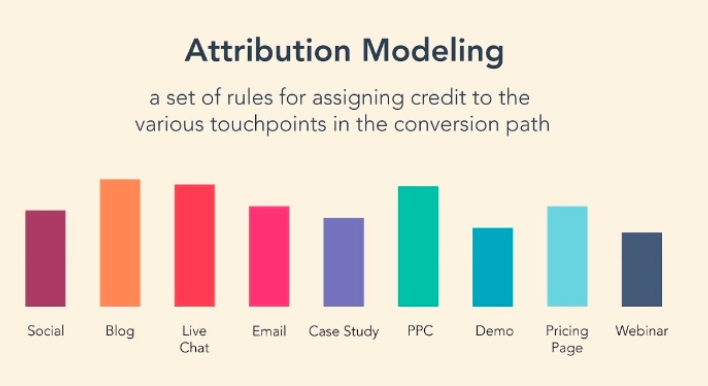Attribution Modeling
Definition
Attribution modeling is analysing and assigning credit to different touchpoints in a customer’s journey that leads to a desired outcome.
Description
Attribution modeling is a methodology used in marketing to understand and measure the impact of various touch points along a customer’s journey towards a conversion or purchase.
It involves analysing and assigning credit to each touchpoint, such as ads, emails, or social media interactions, that lead to the desired outcome.

This allows businesses to optimise their marketing strategies by identifying which channels and tactics are most effective in driving conversions and sales.
Businesses can use various attribution models, such as first-click, last-click, and multi-touch, each with strengths and weaknesses.
Importance of Attribution Modeling
Attribution modeling is important for several reasons:
- Understanding the customer journey: Attribution modeling helps businesses better understand the various touchpoints that influence a customer’s decision to make a purchase or conversion, allowing them to optimise their marketing strategies accordingly.
- Allocating marketing budgets: By identifying which channels and tactics are most effective in driving conversions, businesses can give their marketing budgets more effectively, maximising their return on investment.
- Improving ROI: Attribution modeling helps businesses identify the most effective marketing channels and tactics, optimising their strategies and improving their return on investment.
- Personalising customer experiences: By understanding the customer journey, businesses can personalise their marketing and customer experiences, improving customer satisfaction and loyalty.
- Optimising conversion rates: Attribution modeling helps businesses identify bottlenecks and opportunities in the customer journey, allowing them to optimise their strategies and improve their conversion rates.
What are different attribution models?
Attribution models are methodologies used in marketing to assign credit or value to each touchpoint in a customer’s journey that leads to a desired outcome, such as a purchase or conversion.
There are several types of attribution models that businesses can use to analyse and measure the effectiveness of their marketing strategies, including:
- First-click attribution: Gives all credit to a customer’s first touchpoint with a business.
- Last-click attribution: Gives all credit to a customer’s last touchpoint with a business before making a purchase or conversion.
- Linear attribution: Distributes credit equally across all touchpoints in a customer’s journey.
- Time-decay attribution: Assigns more credit to touchpoints that are closer in time to the purchase or conversion.
- Position-based attribution: Gives more credit to the first and last touchpoints, with the remaining credit distributed equally among the intermediate touchpoints.
- Custom attribution: Allows businesses to create a custom model that aligns with their specific business goals and objectives.
How To Choose The Right Attribution Model?
Choosing the suitable attribution model depends on several factors, including the business’s goals and objectives, the complexity of the customer journey, and the available data. Here are some steps to help choose the suitable attribution model:
- Define business goals and objectives: Identify what outcomes or conversions you want to measure and optimise.
- Analyse customer journey: Analyse the customer journey and identify the touchpoints most influential in driving conversions.
- Consider data availability: Consider the data available to you, such as tracking and measurement tools, and determine which models are feasible to implement.
- Test and compare models: Test different models and compare the results to identify which models align best with your business goals and objectives.
- Consider using multiple models: Consider using multiple models to gain a more comprehensive understanding of the customer journey and optimise your marketing strategies accordingly.
Future Strategy for Attribution modeling
The future prospects of attribution models are promising as marketers seek ways to optimise their marketing efforts and better understand the customer journey. Here are a few potential developments that could shape the future of attribution modeling:
- Integration with emerging technologies: As new technologies such as augmented reality, virtual reality, and voice assistants become more prevalent, attribution models must adapt to account for these touchpoints. This could involve incorporating new data sources or developing new attribution models tailored to these technologies.
- Increased focus on customer experience: Attribution models will increasingly need to account for the overall customer experience rather than individual touchpoints. This could involve measuring metrics such as customer satisfaction, loyalty, and advocacy to understand the impact of marketing efforts on the entire customer journey.
- Cross-device attribution: With consumers using multiple devices to research and purchase products, cross-device attribution will become increasingly important. Attribution models must account for how customers move between devices and how different touchpoints on each device contribute to the final conversion.
- Greater use of machine learning: As data sets become larger and more complex, machine learning algorithms will be essential for analysing data and identifying patterns that can inform attribution models. This could involve developing more sophisticated models that account for multiple variables and accurately assign credit to all touchpoints in the customer journey.
Example
One brand example of attribution modeling is Airbnb. The company uses a multi-touch attribution model that assigns credit to all touchpoints in the customer journey that lead to a booking.
This includes online and offline touchpoints such as social media, search engine advertising, email marketing, and referral programs.

Airbnb also uses a combination of first-party and third-party data sources to inform its attribution model. First-party data includes data generated by user activity on the Airbnb website and mobile app.
In contrast, third-party data contains data from external sources such as advertising networks and data management platforms.
Airbnb uses various metrics to measure its marketing efforts’ effectiveness, including click-through rates, conversion rates, and revenue generated. By analysing these metrics and attributing credit to all touchpoints in the customer journey, Airbnb can optimise its marketing spend and drive more bookings.
FAQ
What is attribution modeling?
Attribution modeling assigns credit to various marketing channels or touchpoints that lead to a conversion. It helps marketers understand the customer journey and optimise their marketing efforts accordingly.
What types of attribution models are there?
There are several types of attribution models, including single-touch models, such as first-click or last-click attribution, and multi-touch models, such as linear or time decay attribution.
Each model has its own strengths and weaknesses and can be tailored to fit the needs of a specific business.
How do you determine which attribution model to use?
The best attribution model for your business will depend on your goals and the nature of your customer journey. Evaluating your marketing channels and determining which touchpoints are most influential in driving conversions is essential.
You can then select an attribution model that accurately reflects the customer journey and assigns credit to those touchpoints.
What are the benefits of using attribution modeling?
Attribution modeling provides several benefits, including a better understanding of the customer journey, the ability to optimise marketing spend across all channels, and the ability to measure the impact of individual marketing campaigns.
How does machine learning fit into attribution modeling?
Machine learning can analyse large and complex data sets, identify patterns and trends that might not be apparent through manual analysis, and accurately assign credit to all touchpoints in the customer journey.
This can help create more sophisticated attribution models that better reflect modern customer journeys’ complex nature.
How do you measure the effectiveness of attribution modeling?
The effectiveness of attribution modeling can be measured through various metrics, including click-through rates, conversion rates, and revenue generated.
You can optimise your marketing efforts and drive more conversions by analysing these metrics and attributing credit to all touchpoints in the customer journey.
Also Read – The customer journey — definition, stages, and benefits





We would love to have your opinion.